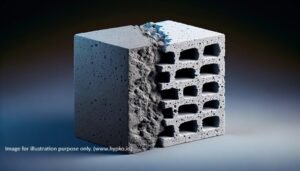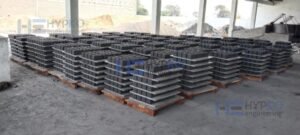Table of Contents
The Dominance in Construction:
Navigating the vast world of building materials, it becomes evident that the selections made can profoundly affect a structure’s resilience, protection, and lifespan. Concrete blocks, alternatively referred to as concrete masonry units (CMUs), have emerged as an unparalleled choice for contemporary builders and designers. With an unparalleled combination of strength, flexibility, and a myriad of benefits, these blocks have become a staple in today’s construction sphere. This article illuminates the realm of solid concrete blocks, highlighting their advantages, contrasting them with hollow variants, and underlining the differences between solid concrete blocks and AAC blocks.

Decoding the Strength of Concrete Blocks:
Concrete blocks are a testament to the evolution of building materials. Precisely crafted from an amalgamation of top-tier elements like Portland cement, aggregates like sand or crushed stone, and occasionally certain admixtures, these blocks are notable for their solid structure, devoid of hollow spaces. Their dense formation ensures an outstanding load-bearing potential and unmatched structural integrity, making them apt for diverse architectural needs.
A Plethora of Benefits:
- Unparalleled Strength: Known for their commendable compressive strength, solid concrete blocks can endure tremendous weights, making them the first choice for load-bearing walls and foundational elements.
- Efficient Thermal Properties: With an increasing emphasis on energy conservation, the inherent thermal insulation capabilities of these blocks come into the limelight. They effectively manage interior temperatures, resulting in minimized energy usage and heightened occupant comfort.
- Fire Resistance: Solid concrete blocks’ dense structure ensures commendable fire resistance, reinforcing the safety quotient of any establishment they integrate into.
- Noise Reduction: Their robust nature aids in sound insulation, guaranteeing a serene indoor ambiance by minimizing external noise disturbances.
- Pest-Resilient: An inherent resistance to pests like termites and rodents ensures your establishment remains safeguarded from potential damages, leading to lower maintenance costs over time.
Solid vs. Hollow Concrete Blocks: An Architectural Conundrum:
The choice between solid and hollow concrete blocks hinges on several considerations. While solid blocks are superior in strength and load-bearing capabilities, making them apt for foundational and structural needs, hollow blocks, with their intrinsic cavities, can be augmented with insulative materials, boosting their thermal efficiency. These lighter, often more budget-friendly blocks are ideal for partitions and non-load-bearing structures, where insulation is prioritized over robust support.
Solid Concrete Blocks versus AAC Blocks: Drawing Distinctions:
Despite certain similarities, solid concrete blocks and AAC blocks have distinct characteristics:
- Composition: While AAC blocks encompass cement, lime, sand, water, and an expansive agent, solid concrete blocks amalgamate cement, aggregates, and water.
- Weight Factors: AAC blocks, owing to their air cavities, are significantly lighter than solid concrete blocks, facilitating easier transportation and handling.
- Insulative Efficiency: AAC blocks surpass solid concrete blocks in insulation due to their cellular structure, reflecting in a higher R-value.
- Strength Dynamics: Solid concrete blocks are typically superior in compressive strength compared to AAC blocks, making them the choice for structures demanding robust support.
Differences Table – Solid Concrete Blocks vs Hollow Blocks vs AAC Blocks:
| Criteria | Solid Concrete Blocks | Hollow Concrete Blocks | AAC Blocks |
|---|---|---|---|
| Composition | Cement, aggregates (such as sand or crushed stone), and water. | Similar to Solid Concrete Blocks but with cavities. | Cement, lime, sand, water, and an expanding agent. |
| Structure | Dense and solid with no hollow spaces. | Characterized by cavities which can be filled with insulating materials. | Lighter due to the presence of air pockets. |
| Weight | Heavier due to solid structure. | Lighter due to cavities. | Considerably lighter because of air pockets, simplifying handling and transportation. |
| Thermal Insulation | Inherent thermal insulation properties, helping in regulating indoor temperatures. | Elevated thermal efficiency when cavities are filled with insulating materials. | Superior insulation properties due to cellular structure, leading to higher R-value. |
| Strength & Load-bearing | Exceptional compressive strength; ideal for load-bearing walls and foundational structures. | Suitable for non-load-bearing walls and where insulation is prioritized over structural support. | Generally lower compressive strength compared to solid concrete blocks; not the primary choice for load-bearing tasks. |
| Fire Resistance | High fire resistance due to dense composition. | Good fire resistance, but slightly less than solid blocks due to cavities. | Good fire resistance, but specifics can vary based on the exact composition and structure. |
| Sound Insulation | Effective sound insulation due to solidity. | Sound insulation can vary based on the thickness and materials used to fill the cavities. | Good sound insulation due to cellular structure. |
| Pest Resistance | Inherently resistant to pests such as termites and rodents. | Similar resistance as solid concrete blocks. | Resistance can vary, but generally resistant to common pests. |
Harnessing the Potential:
Integrating solid concrete blocks into your architectural endeavors unlocks a spectrum of possibilities. Their robustness, longevity, and diverse advantages make them a prudent choice for both housing and business projects. Be it a residential home, a business hub, or a manufacturing unit, solid concrete blocks lay the foundation for your architectural dreams.
The Concrete Block Making Machine – A Revolutionary Tool:
For those aiming to maximize the benefits of solid concrete blocks, the Concrete Block Making Machine is a groundbreaking invention. This cutting-edge equipment accelerates the block production process, churning out industry-standard, top-quality units. Embracing this technology not only guarantees exceptional quality but also enhances production efficacy.
For a deeper dive into solid concrete blocks via the Concrete Block Making Machine, click here.
In Retrospect: Building with Solid Concrete Blocks
Solid concrete blocks are a testament to human innovation in the realm of construction. Their unmatched strength, combined with a plethora of benefits, earmarks them as an integral component of contemporary construction. As you set out on your next architectural journey, contemplate the enduring capabilities of solid concrete blocks – a commitment to structural vigor, longevity, and architectural supremacy.
For individuals who are intrigued by the distinctions between different construction materials, our detailed exploration of solid concrete blocks and AAC blocks offers valuable insights. Further deepening this exploration, a comprehensive article titled “AAC Blocks vs Fly Ash Bricks – 10 Interesting Differences” provides an in-depth comparison between these two popular materials. By understanding the nuances of each material, architects and builders can make more informed decisions in their construction endeavors.



